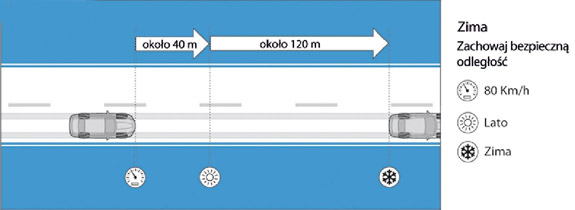 The actual braking time is the time from the moment the brakes are applied until the vehicle is stopped; the vehicle's movement is delayed during this period. You have to remember, that the driver's mental reaction time varies from person to person, and the length of this time depends on the personal organic characteristics of the driver, his age, mental and physical condition. Driver e.g.. tired, not getting enough sleep or after consuming even a small dose of alcohol (big beer) will already have a much longer period of mental reaction than under normal conditions (after a small dose of alcohol, the reaction time is extended by approx 100%). Scientific research has shown, that u healthy, of a well-rested driver, the mental reaction time is on average 0,5 s. If we accept, that the driver's reaction time was 0,5 s, and the vehicle was going fast 50 km/h, it was during this period that he traveled a distance of approx. 7 m, and at 100 km / h approx 15 m. The second section of the braking distance, which car is still traveling at an unchanged speed, falls on the so-called. brake delay period (brake actuation period). And during this period, similar to the driver's reaction period, the length of the distance traveled by the vehicle increases in direct proportion to the speed gain. On the other hand, the length of the road section in effective time (proper) deceleration increases in proportion to the square of the speed increase of the vehicle (e.g. after the speed of the vehicle is doubled, the distance will quadruple; after a fourfold increase in speed, the effective braking distance will increase up to 16 times). The length of the effective braking distance therefore depends primarily on the driving speed, then from: weather conditions (wet road, snow, glaze), type of road surface, condition of tires and technical condition of brakes. On a wet asphalt surface, the car will only stop after approx 52,1 m. You should always remember this and avoid speeding up on wet roads, because even the best brakes won't help.
The actual braking time is the time from the moment the brakes are applied until the vehicle is stopped; the vehicle's movement is delayed during this period. You have to remember, that the driver's mental reaction time varies from person to person, and the length of this time depends on the personal organic characteristics of the driver, his age, mental and physical condition. Driver e.g.. tired, not getting enough sleep or after consuming even a small dose of alcohol (big beer) will already have a much longer period of mental reaction than under normal conditions (after a small dose of alcohol, the reaction time is extended by approx 100%). Scientific research has shown, that u healthy, of a well-rested driver, the mental reaction time is on average 0,5 s. If we accept, that the driver's reaction time was 0,5 s, and the vehicle was going fast 50 km/h, it was during this period that he traveled a distance of approx. 7 m, and at 100 km / h approx 15 m. The second section of the braking distance, which car is still traveling at an unchanged speed, falls on the so-called. brake delay period (brake actuation period). And during this period, similar to the driver's reaction period, the length of the distance traveled by the vehicle increases in direct proportion to the speed gain. On the other hand, the length of the road section in effective time (proper) deceleration increases in proportion to the square of the speed increase of the vehicle (e.g. after the speed of the vehicle is doubled, the distance will quadruple; after a fourfold increase in speed, the effective braking distance will increase up to 16 times). The length of the effective braking distance therefore depends primarily on the driving speed, then from: weather conditions (wet road, snow, glaze), type of road surface, condition of tires and technical condition of brakes. On a wet asphalt surface, the car will only stop after approx 52,1 m. You should always remember this and avoid speeding up on wet roads, because even the best brakes won't help.